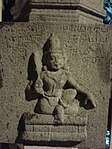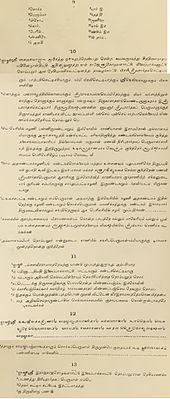Domlur Chokkanathaswamy temple
| Chokkanathaswamy temple | |
|---|---|
| Religion | |
| Affiliation | Hinduism |
| District | Bangalore |
| Deity | Lord Vishnu |
| Location | |
| Location | Bangalore |
| State | Karnataka |
| Country | India |
| Architecture | |
| Completed | 1200 CE |
Chokkanathaswamy temple, at Domlur in the Indian city of Bangalore, Karnataka, India, is dedicated to the deity known as Chokkanathaswamy or Chokka Perumal (the Hindu god Vishnu). It is one of the oldest temples in the city . The temple has numerous Kannada and Tamil inscriptions that have been documented in the Epigraphia Carnatica Vol 9, Bangalore District (1905ed). Based on these inscriptions the temple is at least as old as 1200 CE.
History
[edit]This Chokkanathaswamy temple is considered is amongst the older temples in Bangalore.[1] There are several notable sculptures and decorative features in the complex and the temple faces east.[2] One Tamil inscription dated 1270 CE on a door frame states that the doors were donated by one Alagiyar and another inscription says of donation by one Talaikattu and one more inscription dated 1290 CE states that Poysala Vira Ramanada made donations to the temple.[1] Vijayanagara style Navaranga and pillars are later editions.
-
Chola stone art 10th century - Hindu god Vishnu in Chokkanathaswamy Temple
-
Tamil inscription, 10th century Chola temple, Domlur, Bangalore
Tamil inscriptions
[edit]The Chokkanathaswamy Temple is considered at least as old as 1200 CE based on inscriptions in the temple and documented in the Epigraphia Carnatica Vol 9, located in Domlur. There are a number of Tamil inscriptions in the temple. Domlur is called as Tombalur or Desimanikkapattanam in these inscriptions. Chakravarthi Posalaviraramanatha Deva has left inscriptions with directions to temple authorities of his kingdom. Further some inscriptions record the tributes, taxes and tolls made to the temple by Devaraya II of Vijayanagar Empire, which state the houses, wells, land around Tombalur were offered to the deity Sokkapperumal. Another Tamil inscription dated 1270 talks about 2 door posts being donated by Alagiyar. Yet another inscription in Tamil details Talaikkattu and his wife donating lands from Jalapalli village and Vinnamangalam tank to the deity. A 1290 CE inscription talks about donation of ten pens from the revenue of Tommalur by Poysala vira Ramananda.[3][4][5][6][7][8][9]
-
Tamil inscriptions of the Domlur Chokkanathaswamy Temple, Bangalore
-
Roman script of the Tamil inscriptions of the Domlur Chokkanathaswamy Temple, Bangalore
-
English translations of the Tamil inscriptions of the Domlur Chokkanathaswamy Temple, Bangalore[10]
Present
[edit]The temple has been extensively renovated several times and only the sanctum sanctorum and two ardhamantapas exhibit antiquity.[1] The images of Vishnu, Sridevi and Bhudevi established in Garbhagraha are carved out of Shaligrama stone brought from Gandaki river, in Nepal.[1]
Temple timings
[edit]Daily: Morning: 6:00 am – 11:00 am, Evening: 5:45 pm – 8:30 pm
Wednesday: Morning: 6:00 am – 11:30 am, Evening: 5:45 pm – 8:30 pm
Saturday: Morning: 6:00 am – 12:30 pm, Evening: 5:45 pm – 9:00 pm
References
[edit]- ^ a b c d "History Of the Temple". Archived from the original on 4 January 2015. Retrieved 10 June 2013.
- ^ "India9".
- ^ Rice, Benjamin Lewis (1887). Mysore: A Gazetteer Compiled for Government. London, UK: Asian Educational Services. p. 70. ISBN 8120609778. Retrieved 17 January 2015.
- ^ Githa, U B (19 April 2004). "A Chola temple in Domlur!". No. Bangalore. Deccan Herald. Archived from the original on 4 January 2015. Retrieved 4 January 2015.
- ^ Githa, U B. "Chokkanathaswamy Temple, a fine example of Chola architecture". Chitralakshana: All about Indian Art. Archived from the original on 23 September 2015. Retrieved 17 January 2015.
- ^ Sridhar, Lakshminarasimhan; Sridhar, Geetha. "Chokkanarayan Swamy Temple Domlur". Vishnu Temples of Karnataka. Archived from the original on 18 January 2015. Retrieved 16 January 2015.
- ^ Rao, Priyanka S (19 May 2012). "Chokkanatha: The city's oldest temple". No. Bangalore. The New Indian Express. Archived from the original on 18 January 2015. Retrieved 18 January 2015.
- ^ Harshitha, Samyuktha (10 December 2012). "The temple of the Cholas". Suttha Muttha. Retrieved 25 January 2015.
- ^ Rizvi, Aliyeh (20 October 2014). "Good vibrations". No. Bangalore. Bangalore Mirror. Bangalore Mirror Bureau. Retrieved 6 February 2015.
- ^ Rice, Benjamin Lewis (1894). Epigraphia Carnatica: Volume IX: Inscriptions in the Bangalore District. Mysore State, British India: Mysore Department of Archaeology. Retrieved 5 August 2015.





![English translations of the Tamil inscriptions of the Domlur Chokkanathaswamy Temple, Bangalore[10]](http://upload.wikimedia.org/wikipedia/commons/thumb/2/2d/English_Translations_of_the_Tamil_Inscriptions_of_the_Domlur_Chokkanathaswamy_Temple%2C_Bangalore.jpg/200px-English_Translations_of_the_Tamil_Inscriptions_of_the_Domlur_Chokkanathaswamy_Temple%2C_Bangalore.jpg)